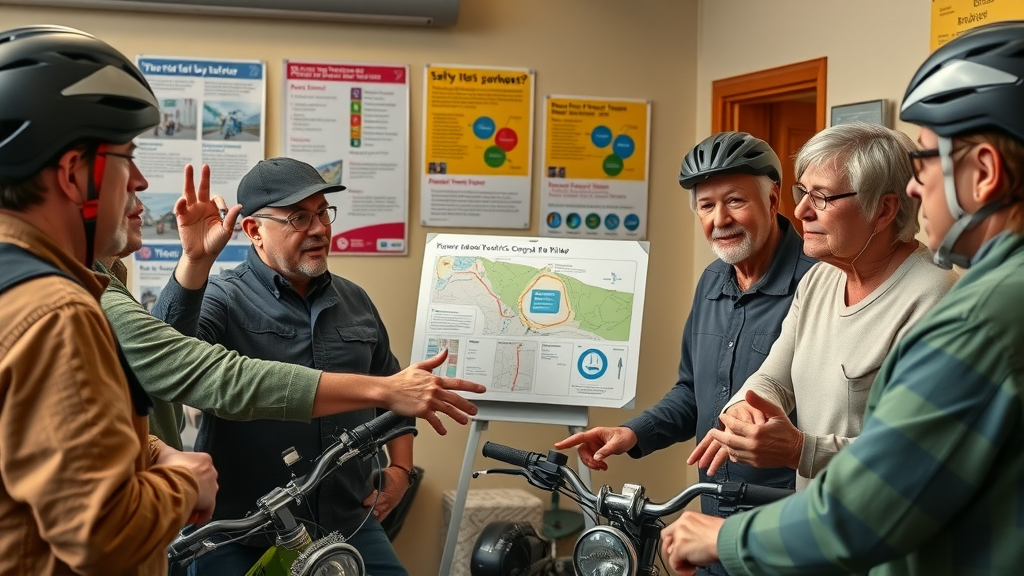Did you know motorcycle fatality numbers have reached alarming highs in recent years? Don’t be another statistic—understand the mistakes you need to avoid for safer rides. Whether you’re a new or seasoned rider, now is the time to get informed, take action, and protect yourself from the growing dangers on the road. This article breaks down why the numbers are spiking, key driver and rider errors, best safety practices, the latest in technology, and crucial steps you can take to reduce your risk. Let’s dig in and start making every ride safer.
Understanding the Recent Rise in Motorcycle Fatality Numbers
The motorcycle fatality numbers have climbed dramatically in recent years, leaving families, lawmakers, and riding communities deeply concerned. Experts attribute this upward trend to a variety of factors including increased traffic, changes in commuting habits, and urban expansion. As cities grow and more vehicles hit the road, the risk to vulnerable road users, especially motorcyclists, escalates. Worse, the spike is not isolated to one region—the phenomenon is being observed on highways and city streets nationwide.
This rise means every rider needs to become more aware of both personal and external risks. Recognizing the contributing factors behind these motorcycle death statistics is essential for anyone who owns, rides, or even shares the road with motorcycles. By understanding the core issues, it becomes possible to adopt new strategies for safety. Throughout this article, we’ll provide practical examples and advice you can use to avoid becoming part of these troubling statistics.

Key Data and Shocking Statistics About Motorcycle Fatality Numbers
Statistics paint a grim picture for motorcyclists in recent years. According to national road safety data, the annual motorcycle fatality numbers reached a decade high last year. In some states, fatal crashes involving motorcycles increased by up to 20% compared to previous averages, with urban intersections and highways leading as hotspots. What’s even more shocking is that despite advancements in vehicle safety, motorcyclists remain 28 times more likely to die in a crash than car occupants.
The latest data underscores the vulnerability of riders, especially those younger than 30 or older than 60. Seasonality is also a factor—fatal accidents often peak during summer months and holiday weekends, when more motorcycles are on the road. Hypotheses for this trend highlight riskier riding behaviors, more powerful motorcycles, and distraction—both by riders and other drivers. These numbers highlight a pressing need for education, policy changes, and individual accountability if we want to reverse the growing tide of motorcycle fatalities.
| Year | Motorcycle Fatalities | Total Vehicle Fatalities | Motorcycle % of Total |
|---|---|---|---|
| 2014 | 4,594 | 32,744 | 14% |
| 2017 | 5,229 | 37,133 | 14% |
| 2020 | 5,579 | 38,824 | 14.4% |
| 2023 | 6,300 (est.) | 39,000 (est.) | 16.2% |
Major Factors Driving the Increase in Motorcycle Fatality Numbers
In examining why motorcycle fatality numbers keep climbing, several major contributing factors are revealed. Distraction has become a significant threat as more drivers—and even some riders—interact with mobile devices, take calls, or use in-dash infotainment systems on the move. The danger is compounded by higher average travel speeds and increasingly unpredictable weather patterns, both of which decrease reaction times and exacerbate risk on two wheels.
Furthermore, the roads themselves have become more complex due to an influx of inexperienced riders, many of whom are enticed by the affordability and fuel efficiency of motorcycles. Alcohol and drug impairment continue to present deadly hazards, both for those operating motorcycles and for other drivers who share the road. Together, these factors combine to create a “perfect storm” that has led directly to rising motorcycle fatality statistics across the nation.
- Distracted Driving
- Speeding
- Weather Conditions
- Inexperienced Riders
- Alcohol and Substance Use

Common Rider Mistakes That Exacerbate Motorcycle Fatality Numbers
The mistakes made by riders themselves play a major role in the troubling rise in motorcycle fatality numbers . Many riders, particularly those with limited experience, may believe that their skills are sufficient to handle emergency situations. This overconfidence leads to underestimating real risks such as poor road surfaces, sharp turns, and unexpected hazards like loose gravel or debris, all of which can quickly become fatal.
Another common error is the lack of consistent safety gear use. Helmets, jackets with armor, gloves, and high-visibility vests save lives—yet too many riders forego proper gear, believing that short trips or familiar routes don’t require protection. These small lapses in judgment can make all the difference in a crash scenario. Additionally, many riders do not adjust their riding style to account for changes in weather, traffic, or visibility, leaving them dangerously exposed to conditions they haven’t prepared for.
Misconceptions and Their Deadly Consequences
Misconceptions about motorcycle safety fuel risky behavior. A common myth is that “loud pipes save lives,” spreading the false belief that increased exhaust noise makes riders safer. In reality, relying on noise rather than skill and attention can result in fatal outcomes. Others may think that experience alone is enough, neglecting regular training and new skill development. This complacency, especially among seasoned riders, often keeps fatality numbers stubbornly high.
Even minor misjudgments—misreading another vehicle’s speed, underestimating braking distances, or failing to scan for hazards—can turn a routine ride into a tragedy. By busting these myths and focusing on sober, skillful, and attentive riding, riders can dramatically reduce the risk of joining the ranks of the yearly fatality statistics.
"The majority of motorcycle accidents are preventable with proper awareness and preparation."
Best Practices and Tips to Lower Motorcycle Fatality Numbers
Mitigating the sharp rise in motorcycle fatality numbers starts with personal responsibility and smart habits. Wearing appropriate protective gear is the baseline: a DOT-approved helmet, abrasion-resistant clothing, gloves, and boots increase your chances of surviving a crash. High-visibility accessories further improve your odds by making you more noticeable to other road users, especially in low-light or urban environments where most collision risks manifest.
Enrolling in advanced safety courses gives both new and seasoned riders a refresher on essential techniques—such as evasive maneuvers, emergency braking, and reading traffic patterns. Regular motorcycle maintenance also can’t be skipped. Keeping tires, brakes, and lights in good working order eliminates avoidable mechanical failures that could lead to catastrophic accidents.
- Always Wear Protective Gear
- Enroll in Advanced Safety Courses
- Conduct Regular Motorcycle Maintenance
- Understand and Adapt to Road Conditions
- Never Mix Alcohol with Riding

Technology and Innovations Aiming to Reduce Motorcycle Fatality Numbers
Technology is playing an increasingly vital role in addressing the rise of motorcycle fatality numbers . Modern motorcycles now come equipped with advanced safety features such as anti-lock braking systems (ABS), traction and stability control, adaptive headlights, and sophisticated crash detection hardware. These tools help stabilize motorcycles in difficult conditions and reduce stopping distances, giving riders crucial seconds in which to react and avoid accidents.
In parallel, law enforcement agencies and government bodies have launched initiatives, ranging from increased patrols in high-risk zones to public education campaigns targeting both riders and non-riders. The goal is not only to encourage the adoption of new safety technologies but also to establish community-based programs that keep safety top-of-mind for everyone sharing the road.
New Motorcycle Safety Features and Law Enforcement Efforts
Manufacturers are innovating rapidly. Features like blind-spot detection, onboard cameras, and emergency contact alerts are now standard or optional in new models. Helmet manufacturers are also leveraging technology—some helmets now come with integrated heads-up displays showing maps, speed, and incoming calls, keeping your hands on the handlebars and attention on the road.
Authorities aren’t just relying on gear. Many have enforced stricter helmet laws, cracked down on reckless driving, and set up workshops or support groups to educate the riding community. Campaigns like “Look Twice, Save a Life” have made measurable impacts in reducing local accident rates, while digital speed limit warnings and mobile alerts warn riders when they enter dangerous areas.

Frequently Asked Questions About Motorcycle Fatality Numbers
- What are the main causes of motorcycle fatalities?
- How can new riders reduce their risk of fatal accidents?
- Are certain motorcycle models safer than others?
- How do motorcycle fatality numbers compare to car fatalities?
- What are the most dangerous times and locations for motorcycle riders?
Addressing People Also Ask: Detailed Answers
What are the main causes of motorcycle fatalities?
The main causes of motorcycle fatalities include speeding, distracted driving (by both riders and other road users), alcohol or substance impairment, adverse weather, and lack of protective gear use. Environmental factors such as poorly maintained roads and high-traffic intersections often play a role. These elements, combined with the inherent vulnerability of riders, contribute significantly to the high rate of motorcycle-related deaths.
Rider experience also matters: new or returning riders tend to be overrepresented in accident statistics because of inadequate training or outdated skills. By addressing these areas with training, awareness, and responsible riding, the community can make meaningful progress in lowering these tragic numbers.

How can new riders reduce their risk of fatal accidents?
New riders can dramatically lower their risk of fatal accidents by committing to key safety principles. First, always wear a certified helmet and protective gear—this is non-negotiable. Taking a motorcycle safety course, such as those offered by local DMVs or certified training centers, equips riders with crucial skills for handling emergency situations and understanding road dynamics.
Consistency in maintenance, awareness of surroundings, and avoiding risky maneuvers such as lane splitting or high-speed weaving also save lives. New riders should also avoid riding in bad weather until fully comfortable and never operate a motorcycle under the influence of alcohol or drugs. Becoming a defensive, proactive, and focused rider is the surest way to stay safe.
Key Steps Every Rider Should Take as Motorcycle Fatality Numbers Increase
With the continuous rise in motorcycle fatality numbers , adopting a proactive safety-first mindset is more critical than ever. It’s important to stay informed on the latest safety guidelines, technology updates, and trends in accident statistics. By engaging with the riding community, you gain support and insight that enhances your awareness on and off the road.
Commit to defensive riding—maintain safe following distances, anticipate the actions of others, and adapt riding habits to changing road or weather conditions. Promote safety cultures among friends and in riding groups, encouraging joint responsibility. Furthermore, support advocacy and awareness campaigns that aim to improve infrastructure, enforce traffic laws, and push for better rider education.
- Stay Informed on Current Trends
- Commit to Defensive Riding
- Encourage Safe Riding Among Peers
- Support Advocacy and Awareness Campaigns

Summary: Proactive Choices to Help Reverse Motorcycle Fatality Numbers
Make informed decisions, adopt best practices, embrace new technology, and inspire fellow riders. Your proactive choices today can help reverse the increase in motorcycle fatality numbers and create safer journeys for everyone.
Motorcycle fatalities have reached alarming levels in recent years, underscoring the critical need for enhanced safety measures. According to the National Highway Traffic Safety Administration (NHTSA), motorcyclists accounted for 15% of all traffic fatalities in 2023, with a fatality rate nearly 28 times higher than that of passenger car occupants. ( nhtsa.gov ) This stark statistic highlights the vulnerability of motorcyclists on the road.
A significant factor contributing to these fatalities is the lack of helmet use. A study by the Insurance Institute for Highway Safety (IIHS) estimates that approximately 22,058 motorcyclists’ lives could have been saved between 1976 and 2022 if all states had implemented universal helmet laws. ( apnews.com ) This finding emphasizes the life-saving potential of consistent helmet usage.
To address this growing concern, NHTSA has launched initiatives such as Motorcycle Safety Awareness Month, aiming to educate both riders and drivers about the importance of sharing the road and adhering to safety practices. ( nhtsa.gov ) These efforts are crucial in promoting a culture of safety and reducing the incidence of motorcycle-related fatalities.
By staying informed and adopting recommended safety measures, riders can significantly reduce their risk of becoming part of these troubling statistics.
 Add Row
Add Row  Add
Add 




 Add Row
Add Row  Add
Add 



Write A Comment